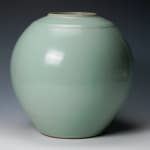Nakashima Hiroshi 中島 宏 1941-2018
Celadon Jar 青磁壺
Celadon
H12 1/4 × Dia 13 in.
H30.9 × Dia 33 cm
H30.9 × Dia 33 cm
With signed wood box
Sold
Further images
-
(View a larger image of thumbnail 1
)

-
(View a larger image of thumbnail 2
)

-
(View a larger image of thumbnail 3
)

-
(View a larger image of thumbnail 4
)

-
(View a larger image of thumbnail 5
)

-
(View a larger image of thumbnail 6
)

-
(View a larger image of thumbnail 7
)

-
(View a larger image of thumbnail 8
)

-
(View a larger image of thumbnail 9
)

-
(View a larger image of thumbnail 10
)

-
(View a larger image of thumbnail 11
)

-
(View a larger image of thumbnail 12
)

-
(View a larger image of thumbnail 13
)

Nakashima Hiroshi’s famed blue-green glazes are historically grounded in Chinese Song dynasty celadon. His pieces are inspired by traditional Chinese metal receptacles, exemplified by an emphasis on the size and...
Nakashima Hiroshi’s famed blue-green glazes are historically grounded in Chinese Song dynasty celadon. His pieces are inspired by traditional Chinese metal receptacles, exemplified by an emphasis on the size and scale of vessels. In particular, he studied the forms of Han and Tang dynasty bronze objects from the archives of Japan’s national collections, which showcases an extensive history of Chinese archaeology. His interest in archaeology and history is reflected in his works. His alchemic approach to form, glaze, and surface results in a grandeur that few contemporary celadon potters are able to achieve.
His commitment to tradition reveals a level of detail sought after by many contemporary celadon artists. In particular his fired glazes took advantage of the thick viscosity that the iconic blue-green glaze offers. As a result, his forms are adorned with a textural sensitivity. Under different light, Nakashima’s vessels offer an undulating surface scape, wherein the craqueleur of his celadon seems to shift and change the color of the glaze. The sea-green landscape of his regal forms shifts into an ocean blue. Nakashima’s transfiguration of celadon earned him the title of Living National Treasure in 2007.
His commitment to tradition reveals a level of detail sought after by many contemporary celadon artists. In particular his fired glazes took advantage of the thick viscosity that the iconic blue-green glaze offers. As a result, his forms are adorned with a textural sensitivity. Under different light, Nakashima’s vessels offer an undulating surface scape, wherein the craqueleur of his celadon seems to shift and change the color of the glaze. The sea-green landscape of his regal forms shifts into an ocean blue. Nakashima’s transfiguration of celadon earned him the title of Living National Treasure in 2007.












